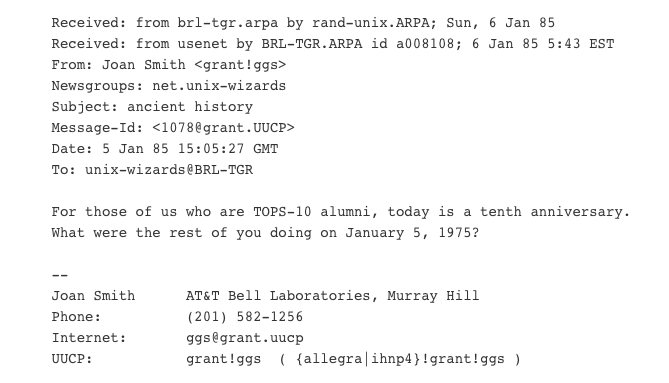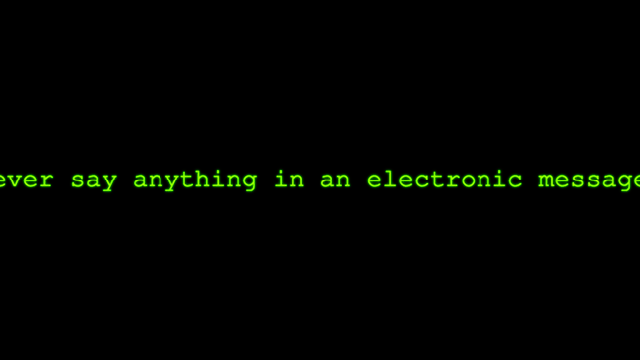Never say anything in an electronic message that you wouldn’t want appearing, and attributed to you, in tomorrow’s front-page headline in the New York Times. That was the advice of Colonel David Russell, head of the IPTO at DARPA in the mid-1970s and it still holds true today.
In 1985 RAND issued a report on the future of email, a document that’s an interesting snapshot of internet history — a period long before the internet and email would become mainstream. Called Toward an Ethics and Etiquette for Electronic Mail, some of the suggestions, like that quote from Russell, are still sound advice. Other things, like use of the word “rot13” as a kind of not-safe-for-work warning, sound about as antiquated as an early 20th century column on manners. Or perhaps something from a softcore cyberpunk zine of the late ’80s.
The authors of the report, Norman Z. Shapiro and Robert H. Anderson, understood that electronic communication was about to explode. The internet, still largely the domain of university researchers and the military in 1985, knew that everyone from businesspeople to young kids would be using it in the very near future:
The authors of this report have each used electronic mail for over 15 years. For this particular medium, that is a long time. In the longer cultural history of us all, it is a very short time. The medium is in its infancy, and is about to undergo an explosive expansion. Tens of thousands of people — secretaries, managers, professionals, school kids — will begin using electronic mail in the next decade, on their personal computers at home and professional workstations at work.
We believe that electronic mail is a fundamentally new medium. It is very different from telephone calls, interoffice memos, written letters, and face-to-face conversations. It has different uses and a different etiquette, borrowing in many cases from familiar ways of communicating, but permuting the rules in the process.
One of the main things that the authors wanted to stress was that despite its ephemeral appearance, users should expect that email was for all practical purposes a permanent medium. If you thought about sending an angry email to a colleague or a gossipy message about someone else, that message could easily be forwarded or stored without the sender’s knowledge. It’s common sense today, but even here in the early 21st century, people seem to forget this.
Unlike a face-to-face conversation, or even a phone call, the email is a “volatile” medium, as the authors described it. And there were dozens of ways that your message, ostensibly sent to just one person, could be spread or stored forever.
From the report:
- That message might reside indefinitely on a disk file, and can therefore be recalled.
- The disk file may be backed up each evening onto tape, so that a copy of the message is now buried in an archived tape in the recipient’s institution, or on an archived diskette on the recipient’s home computer.
- The message can be printed and filed, thereby instantly achieving some of the attributes of a printed memo or letter.
- The message can be altered, then printed, thereby looking like a permanent, authentic copy of the received message, but having altered characteristics.
- The message can be forwarded to third parties (and then fourth, and so on) at the push of a button, without the original author’s knowledge. It therefore achieves a form of permanence through its replication in perhaps hundreds of computer systems throughout the country. But nothing indicates whether those are authentic copies or not, even though they might well have the original author’s name attached.
- Printed copies of the message, no longer under the control of the author, can be laser-printed or typeset. These may appear much more official and substantial than was ever intended by the author at the keyboard of his PC late one evening.
That’s quite a list of considerations. And while the wording may be out of date (like the use of storage on diskette, or “typeset”), the core message remains as true today as it did in 1985.
The authors also imagined that the widespread use of email would cause a kind of chaos in the business and military community. The chain of command in both could easily be circumvented without passing through the “proper” channels. High level execs in business had gatekeepers like receptionists that would keep out unwanted messages. With the rise of email, all one had to do to reach a person in power was know their email address.
These mechanisms have evolved to support the corporate structure, and to conserve the time and attention of its executives. Comparable mechanisms are not yet in place for electronic mail. Executives working in the evening at personal computers at home can send messages without “copying” their secretaries, resulting in those secretaries being “out of the loop” on matters of which they’re normally aware. A junior executive can send a message to a senior executive, bypassing several levels of control.
And what about spam, which hadn’t yet acquired that name? The report included a snapshot of some spam that had landed in one of the author’s inboxes due to a list that he belonged to.
Electronic mail tends to be more “democratic” (some would say “anarchic”). Already, there is the electronic equivalent of junk mail:

What were the solutions? The authors raised the questions while acknowledging that they didn’t necessarily have the answers:
Do we need unlisted electronic mailboxes? Will there be authorization lists (electronic files, of course) showing who can send a message to whom within the organisation? Should message systems automatically send an information copy to the author’s secretary, unless explicitly overridden by the sender? Will “back channels” of information flow, made much easier and in some cases more anonymous by electronic mail, erode the traditional corporate structure? Is this good or bad? For whom?
The report also spelled out the various shorthand that was necessary for proper email etiquette. Some that we still use today, like “spoiler” to warn people that you might be revealing some crucial twist in a movie and emoticons. Other shorthand like “rot13” which have fallen out of fashion, is more often replaced with things like NSFW here in the year 2015:
- “smiley face” symbol, typed as “:->” or “:-)” (turn the page a quarter-turn clockwise for maximum effect), indicates the author intends something as a joke, or less frequently as an ironic smile.
- The keyword “spoiler” is used in the subject field of messages that reveal the plots of movies or the like.
- There is a convention of using public encryption for messages (including spoilers or obscene jokes) that might be offensive to casual readers. The keyword “rot13” is used in the subject field to indicate the use of a standard encryption algorithm.
The long and the short of it? The authors of this RAND report saw electronic communications as a revolutionary force in human interaction just over the horizon. And they weren’t wrong. But perhaps they were a bit hyperbolic in laying out the context for how things would evolve:
People have had about 50,000 years’ experience in the use of speech and gestures, 5,000 years’ experience in writing, and about 100 years’ use of the telephone. This cultural history should not be taken lightly; the entire fabric of our society has been shaped in significant part by cultural accommodations to our means of communicating.
Yes, humans have taken some time to adapt to the internet and so many things are often lost in translation. And yes, we still need to work on our cultural understanding of this relatively new medium of human expression. But some of the answers to the questions that they pose — many of which we’re still wrestling with today — may not be the answers we like.
Yes, email is permanent and you need to treat it as such. Yes, you may inadvertently offend people by your omission or inclusion of the wrong emoticon. But every means of communication, from face-to-face conferences to telephone conversations, have their opportunities for disaster. I guess human communication has always been a disaster. Today it just has more eggplant emojis.
Gif by Andrew Liszewski
